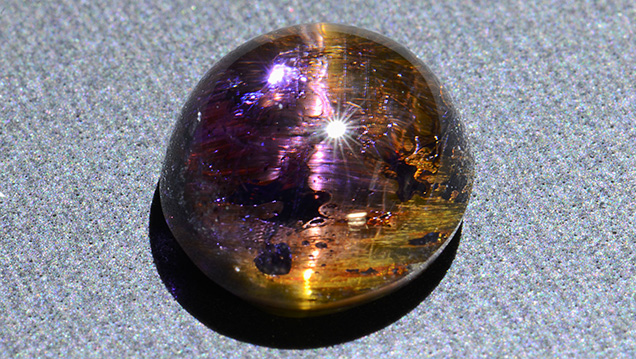Chatoyant Quartz/Tourmaline Doublet

Doublets are assemblages of two different materials, often joined with cement. Historically they were composed of inexpensive materials used to imitate precious stones. Recently new combinations have been reported, such as a beryl/topaz doublet (Winter 2014 GNI, pp. 306–307), synthetic sapphire/synthetic spinel doublets (Winter 2016 Lab Notes, pp. 418–419), and a beryl/glass complex assemblage (Summer 2018 Lab Notes, pp. 206–208).
GIA’s Tokyo laboratory had the chance to examine a unique doublet. The 4.86 ct purplish cabochon, measuring 11.07 × 10.00 × 5.94 mm, appeared to display chatoyancy with a yellowish sheen (figure 1). The hydrostatic specific gravity (SG) and spot refractive index (RI) readings were 2.66 and 1.54, respectively. Assembled features with a cemented plane were easily recognized when viewed from the side, as shown in figure 2. Standard gemological testing, microscopic observation, and infrared spectra revealed that the cabochon segment was a natural amethyst. There were no parallel inclusions that might have caused chatoyancy in this segment. On the other hand, the semitransparent yellowish base had parallel striations and tube-like inclusions throughout (figure 3). Raman spectroscopy identified the base as tourmaline.


Parallel inclusions located near the bottom of a cabochon can create a chatoyant phenomenon (Winter 2017 Lab Notes, pp. 459–460). This assembled item displayed a similar effect due to the flat tourmaline base with parallel structures. When light was reflected through the amethyst by the tourmaline base, the parallel striations and tube-like inclusions in the tourmaline created the band of reflected light that appeared on the cabochon. Transparent amethyst and semitransparent yellow tourmaline are an uncommon combination. This doublet is an example that assemblages are not always aimed to imitate precious stones but can be creative artworks.



